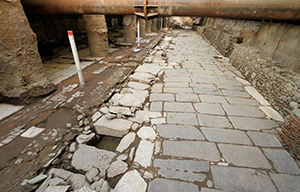Τόμος 3, Τεύχος 3 Σεπτέμβριος - Δεκέμβριος 2019
Μετρό Θεσσαλονίκης - Αρχαιολογικός Χώρος Σταθμού Βενιζέλου
Διατήρηση «κατά χώραν» και ανάδειξη ή το χρονικό μιας χαμένης ευκαιρίας για την πόλη;
Μελίνα Παϊσίδου
Αναπληρώτρια Καθηγήτρια Βυζαντινής Αρχαιολογίας, Τμήμα Ιστορίας και Αρχαιολογίας, Αριστοτέλειο Πανεπιστήμιο Θεσσαλονίκης
 Το κείμενο εκθέτει τους λόγους υπεράσπισης της «κατά χώραν» παραμονής και ανάδειξης του σημαντικού αρχαιολογικού χώρου που απο-καλύφθηκε στη Θεσσαλονίκη κατά την κατα-σκευή του Σταθμού Βενιζέλου του Μετρό της πόλης. Πρόκειται για ένα πολεοδομικό σύνολο που διασώζει τον κεντρικό οριζόντιο άξονα της πόλης με τα εκατέρωθεν καταστήματα και εργαστήρια, τη διασταύρωσή του με μία κεντρική κάθετη οδό και τη διαμόρφωση μίας πλατείας, με χρονολογική τεκμηρίωση από τον 4ο αι. μ.Χ. έως και τον 9ο αι. μ.Χ.
Το κείμενο εκθέτει τους λόγους υπεράσπισης της «κατά χώραν» παραμονής και ανάδειξης του σημαντικού αρχαιολογικού χώρου που απο-καλύφθηκε στη Θεσσαλονίκη κατά την κατα-σκευή του Σταθμού Βενιζέλου του Μετρό της πόλης. Πρόκειται για ένα πολεοδομικό σύνολο που διασώζει τον κεντρικό οριζόντιο άξονα της πόλης με τα εκατέρωθεν καταστήματα και εργαστήρια, τη διασταύρωσή του με μία κεντρική κάθετη οδό και τη διαμόρφωση μίας πλατείας, με χρονολογική τεκμηρίωση από τον 4ο αι. μ.Χ. έως και τον 9ο αι. μ.Χ.
Λέξεις ευρετηρίου: πολεοδομία, βυζαντινή Θεσσαλονίκη, decumanus maximus, αρχαιολογική νομοθεσία, διεθνείς συμβάσεις, δημόσια αρχαιολογία
COPYRIGHT: © Θέματα Αρχαιολογίας, 2019 - ISSN 2653-9292
Επικοινωνία με την συγγραφέα:
Το πρωτότυπο άρθρο βρίσκεται στη βιβλιοθήκη του περιοδικού Θέματα Αρχαιολογίας
![]()
Αυτό το άρθρο χορηγείται με άδεια Creative Commons Αναφορά Δημιουργού-Μη Εμπορική Χρήση-Όχι Παράγωγα Έργα 4.0 Διεθνές .
Volume 3, Issue 3 September - December 2019
Thessaloniki’s Subway: The Archaeological Site of the Venizelos’ Station
An “in situ” maintenance or the chronicle of a missed opportunity for the city?
Melina Paisidou
Associate Professor in Byzantine Archaeology, Department of History and Archaeology, Aristotle University of Thessaloniki, Greece
 The text concerns the issue of the “in situ” maintenance of the most important archaeological findings that have been excavated in the historical center of Thessaloniki, during the works of the Metro construction in the Venizelos Station. Namely, the urban planning of the early Christian and byzantine Thessaloniki from the 4th to the 9th centuries has been revealed in an archaeological site of 1500 m2. A considerable part of the decumanus maximus of the city, of its monumental crossroad with the vertical cardo, of a public square and of numerous stores and workshops are displayed. According to the national archaeological legislation and to the international conventions for the monuments and sites, the whole area must be maintained, protected and rendered to the public as a good of worldwide importance.
The text concerns the issue of the “in situ” maintenance of the most important archaeological findings that have been excavated in the historical center of Thessaloniki, during the works of the Metro construction in the Venizelos Station. Namely, the urban planning of the early Christian and byzantine Thessaloniki from the 4th to the 9th centuries has been revealed in an archaeological site of 1500 m2. A considerable part of the decumanus maximus of the city, of its monumental crossroad with the vertical cardo, of a public square and of numerous stores and workshops are displayed. According to the national archaeological legislation and to the international conventions for the monuments and sites, the whole area must be maintained, protected and rendered to the public as a good of worldwide importance.
Key words: Urban planning, byzantine Thessaloniki, decumanus maximus, archaeological legislation, international conventions, public archaeology
COPYRIGHT: © Themes in Archaeology, 2019 - ISSN 2653-9292
Author for correspondence:
The original article is in the Library of the Themes in Archeology
![]() Creative Commons Attribution-NonCommercial-NoDerivatives 4.0 International .
Creative Commons Attribution-NonCommercial-NoDerivatives 4.0 International .
Διαβάστε το άρθροΑνάτυπο PDF
Το πρωτότυπο άρθρο βρίσκεται στη βιβλιοθήκη του περιοδικού Θέματα Αρχαιολογίας
![]() Αυτό το άρθρο χορηγείται με άδεια Creative Commons Αναφορά Δημιουργού-Μη Εμπορική Χρήση-Όχι Παράγωγα Έργα 4.0 Διεθνές .
Αυτό το άρθρο χορηγείται με άδεια Creative Commons Αναφορά Δημιουργού-Μη Εμπορική Χρήση-Όχι Παράγωγα Έργα 4.0 Διεθνές .
